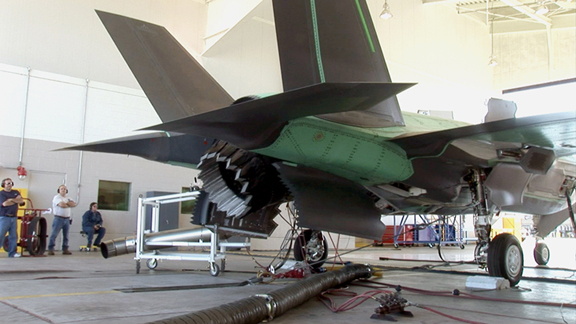The final series of ground engine tests of the first F-35B short takeoff/vertical landing test aircraft that will pave the way for the first flight of the aircraft later this year began April 18, Lockheed Martin announced April 25. On the 18th, UK test pilot Graham Tomlinson of BAE Systems ran the aircraft’s Pratt & Whitney F135 engine for the first time, throttling up to full military power—meaning no non-afterburner—in two consecutive tests that yielded nearly an hour of total run time. The engine runs were part of the F-35B’s first comprehensive systems checkout on the aircraft’s own power, according to Lockheed Martin. When the F-35B does take to the air, which is expected in late May or June, it will fly initially only in conventional flight mode. In early 2009, the aircraft will begin engaging its STOVL propulsion system for short takeoffs, vertical landings, and hovers, the company said. Meanwhile the first F-35A test aircraft, a conventional takeoff and landing variant, has completed 40 flights. In related news, although we haven’t seen the official acquisition decision memorandum yet, press reports indicate that Pentagon acquisition czar John Young has approved full funding for the six F-35As that will be built during lot 2 of F-35 production. He has also approved the funding for the six F-35Bs to be manufactured under lot 2, but has conditioned the release of funding for them on a successful flight. His decision, which resulted from a March 26 review of the F-35 program also reportedly released funds for the purchase of long-lead-time items for lot 3 aircraft.
final series of ground engine tests of the first F-35B short takeoff/vertical landing test aircraft that will pave the way for the first flight of the aircraft later this year began April 18, Lockheed Martin announced April 25. On the 18th, UK test pilot Graham Tomlinson of BAE Systems ran the aircraft’s Pratt & Whitney F135 engine for the first time, throttling up to full military power—meaning no non-afterburner—in two consecutive tests that yielded nearly an hour of total run time. The engine runs were part of the F-35B’s first comprehensive systems checkout on the aircraft’s own power, according to Lockheed Martin. When the F-35B does take to the air, which is expected in late May or June, it will fly initially only in conventional flight mode. In early 2009, the aircraft will begin engaging its STOVL propulsion system for short takeoffs, vertical landings, and hovers, the company said. Meanwhile the first F-35A test aircraft, a conventional takeoff and landing variant, has completed 40 flights. In related news, although we haven’t seen the official acquisition decision memorandum yet, press reports indicate that Pentagon acquisition czar John Young has approved full funding for the six F-35As that will be built during lot 2 of F-35 production. He has also approved the funding for the six F-35Bs to be manufactured under lot 2, but has conditioned the release of funding for them on a successful flight. His decision, which resulted from a March 26 review of the F-35 program also reportedly released funds for the purchase of long-lead-time items for lot 3 aircraft.
As with previous stealth aircraft unveilings, the Air Force’s imagery of the F-47 Next-Generation Air Dominance fighter has been doctored to keep adversaries guessing about its true shaping and design philosophy.